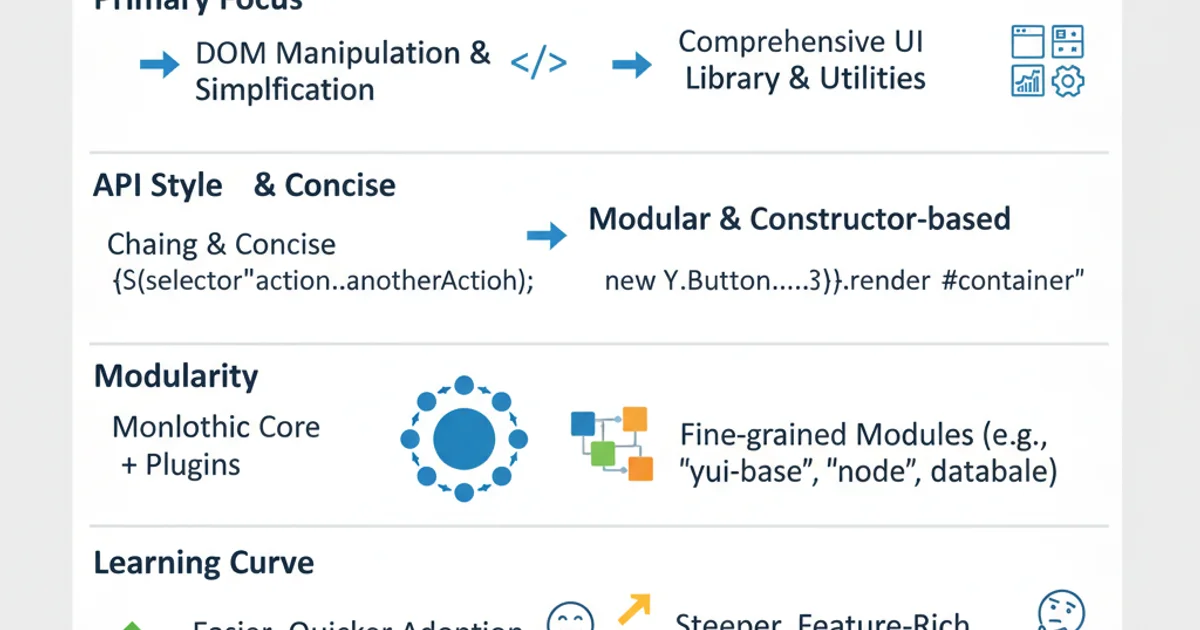jQuery vs. Yahoo UI API design
Categories:
jQuery vs. Yahoo UI: A Deep Dive into JavaScript Library Design

Explore the fundamental differences in API design philosophies between jQuery and Yahoo UI (YUI), understanding their impact on development, performance, and maintainability.
In the early days of web development, JavaScript libraries emerged to simplify client-side scripting, address browser inconsistencies, and enhance user interfaces. Among the most prominent were jQuery and Yahoo UI (YUI). While both aimed to empower developers, their approaches to API design, feature sets, and overall philosophy diverged significantly. This article delves into these differences, highlighting how each library's design choices influenced its adoption, use cases, and legacy.
jQuery: The 'Write Less, Do More' Philosophy
jQuery, released in 2006, quickly gained immense popularity due to its elegant, concise syntax and focus on DOM manipulation, event handling, and AJAX. Its core philosophy was 'Write Less, Do More,' emphasizing ease of use and a low barrier to entry. The API was designed to be intuitive, chainable, and highly expressive, making common web tasks remarkably simple.
$('#myElement').addClass('highlight').slideDown('slow', function() {
console.log('Animation complete!');
});
$.ajax({
url: '/api/data',
method: 'GET',
success: function(data) {
$('#result').html(data);
}
});
Typical jQuery code demonstrating DOM manipulation, animation, and AJAX.
flowchart TD
A[Start: Developer Goal] --> B{Simplify DOM Manipulation?}
B -- Yes --> C[jQuery: Select Element]
C --> D[jQuery: Apply Method (e.g., .addClass(), .hide())]
D --> E[jQuery: Chain Methods]
E --> F[End: Concise Code]
B -- No --> G{Need Comprehensive UI Widgets?}
G -- Yes --> H[Consider YUI]Decision flow for choosing jQuery based on common use cases.
Yahoo UI (YUI): The Enterprise-Grade Toolkit
YUI, also launched in 2006, took a different path. Developed by Yahoo! Inc., it was conceived as a comprehensive, modular library for building highly interactive and robust web applications. YUI offered a vast array of components, from UI widgets (buttons, calendars, data tables) and utility modules (animation, drag-and-drop) to a full-fledged module loader and build system. Its design prioritized robustness, cross-browser compatibility, and a structured, object-oriented approach, often appealing to larger enterprise projects.
YUI().use('node', 'anim', 'dd', function (Y) {
var node = Y.one('#myElement');
node.addClass('highlight');
var anim = new Y.Anim({
node: node,
to: { opacity: 0.5 },
duration: 1
});
anim.run();
var dd = new Y.DD.Drag({
node: '#draggable'
});
});
Example of YUI code demonstrating module loading, DOM manipulation, animation, and drag-and-drop functionality.
classDiagram
class YUI {
+ YUI.use(modules, callback)
+ Y.Node
+ Y.Anim
+ Y.DD.Drag
+ Y.Widget
+ ... (many more modules)
}
class jQuery {
+ $(selector)
+ .addClass()
+ .slideDown()
+ .ajax()
+ ... (core methods)
}
YUI <|-- Y.Node : has
YUI <|-- Y.Anim : has
YUI <|-- Y.DD.Drag : has
jQuery --|> DOM : manipulates
YUI --|> Application : buildsSimplified class diagram illustrating the architectural differences between YUI's modularity and jQuery's core focus.
Key API Design Differences and Their Impact
The divergence in their core philosophies led to distinct API design choices with significant implications for developers:
Scope and Feature Set: jQuery focused on a narrow, yet powerful, set of functionalities primarily centered around DOM manipulation. YUI, conversely, aimed to be a complete application development framework, offering everything from UI controls to low-level utilities.
Modularity vs. Monolithic Core: jQuery had a relatively monolithic core, with plugins extending its functionality. YUI was built from the ground up with a robust module system, allowing developers to load only the components they needed, leading to more optimized builds for complex applications.
Syntax and Learning Curve: jQuery's
$()selector and chainable methods provided an incredibly intuitive and easy-to-learn syntax. YUI, with its more object-oriented and namespaced approach (Y.one(),new Y.Anim()), required a deeper understanding of its architecture.Object-Oriented vs. Functional: YUI embraced classical object-oriented programming patterns, providing classes and inheritance for building complex components. jQuery leaned more towards a functional, utility-based approach, operating on sets of DOM elements.
Performance Considerations: While jQuery was often perceived as 'lighter' due to its smaller core, YUI's modular loading could lead to more performant applications in scenarios requiring many distinct features, as only necessary code was loaded. However, YUI's initial setup and parsing could be heavier.

Comparative overview of jQuery and YUI design philosophies.
Ultimately, both libraries served their purpose well within their respective design paradigms. jQuery became the dominant force for general web development due to its accessibility, while YUI found its niche in large-scale, enterprise-grade applications requiring a structured, component-based approach. The lessons learned from their designs continue to influence modern JavaScript frameworks and libraries today.